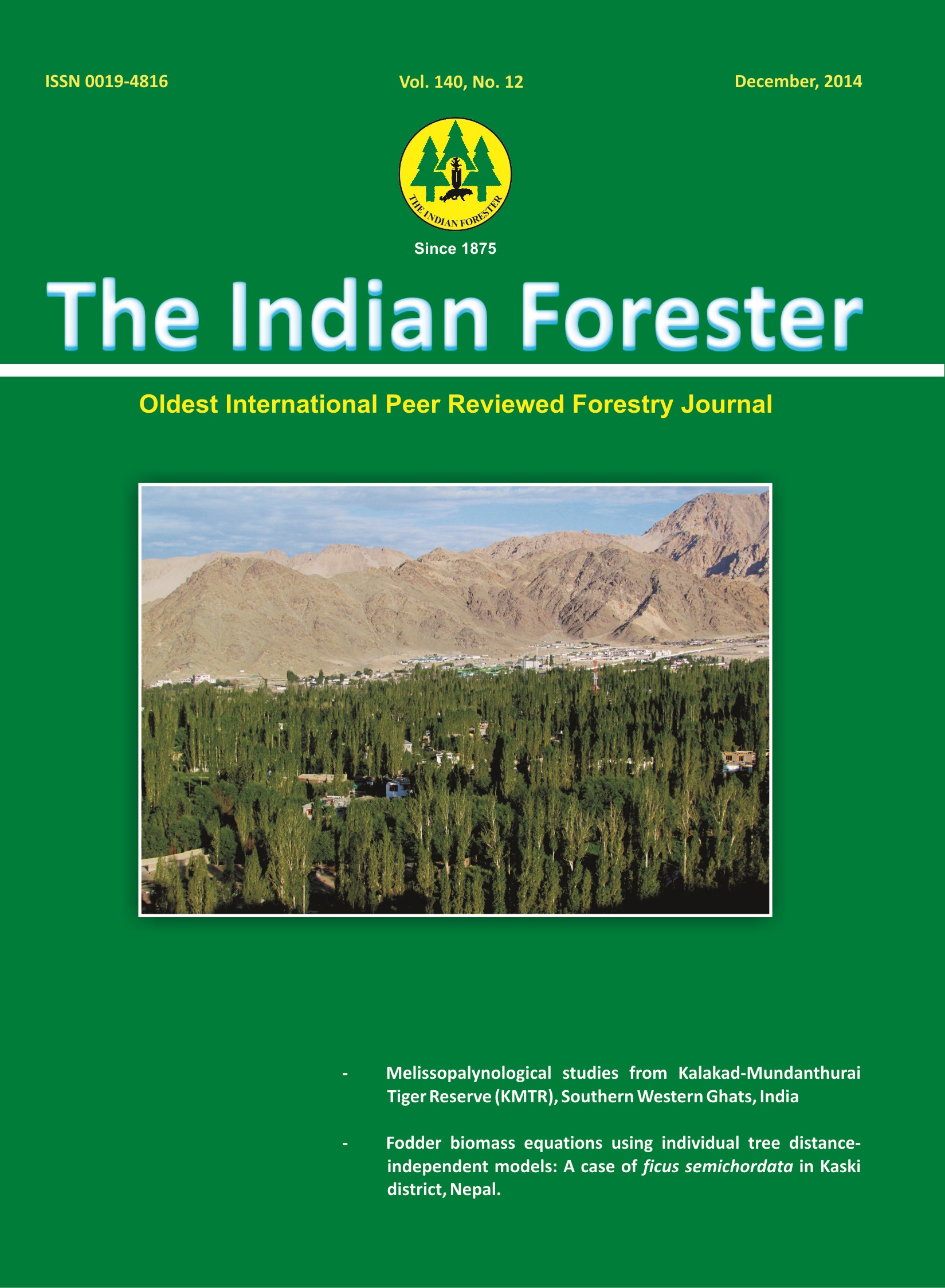Parthenium hysterophorus L. - Neither Noxious nor an Obnoxious Weed
DOI:
https://doi.org/10.36808/if/2014/v140i12/55297Keywords:
No KeywordAbstract
No AbstractReferences
Ajmal M., Rao R.A.K., Ahmad R. and Khan M. A. (2006). Adsorption studies on Parthenium hysterophorous weed: removal and recovery of Cd(II) from wastewater, J. Haz. Mat., 135: 242–248.
Badoni A.L., Mendionodo M.L., Rondina R.V.D. and Coussia J.D. (1972). Survey of Argentine Medicinal Plants – I. Folklore and Phytochemical Screening, Lloydia, 35: 68–80.
Bennet S.S.R. (1985). Ethnobotanical studies in West Sikkim, J. Econ. Taxon. Bot., 7(2): 317–321.
Curtis J. (1821). Botanical Magzine, Edward Couchman, London. p.2275.
Das B., Reddy V.S., Krishnaiah M., Sharma A.V.S., Kumar K.R., Rao J.V. and Sridhar V. (2007). Acetylated pseudoguaianolides from Parthenium hysterophorusand their cytotoxic activity, Phytochemistry, 68: 2029–2034.
Datta S. and Saxena D.B. (2001). Pesticidal properties of parthenin (from Parthenium hysterophorus) and related compounds, Pest. Manag. Sci., 57: 95–101.
Dwivedi P., Vivekanand V., Ganguly R. and Singh R.P. (2009). Parthenium sp. as a plant biomass for the production of alkalitolerant xylanase from mutant Penicillium oxalicum SAU-3.510 in submerged fermentation, Biomass Energy, 33: 581–588. E
Gunaseelan V. N. (1987). Partheniumas an additive with cattle manure in biogas production, Biol. Wastes, 21: 195–202.
Gunaseelan V. N. (1998). Impact of anaerobic digestion of inhibition potential of Parthenium soids, Biomass Bioenergy, 14: 179–184.
Javaid A. and Shah M.B.M. (2010). Growth and yield response of wheat to EM (effective microorganisms) and Parthenium green manure, Afr. J. Biotechnol., 9: 3373–3381.
Kishor P., Ghosh A.K., Singh S. and Maury B.R. (2010). Potential use of Parthenium (Parthenium hysterophorus L.) in agriculture, Asian J. Agric. Res., 4: 220–225.
Lata H., Garg V.K. and Gupta R.K. (2007). Removal of a basic dye from aqueous solution by adsorption using Parthenium hysterophorus: an agricultural waste, Dyes Pigment, 74: 653–658.
Lata H., Garg V.K. and Gupta R.K. (2008). Sequestration of nickel from aqueous solution onto activated carbon prepared from Parthenium hysterophorus L., J. Haz. Mat., 137: 503–509.
Maishi A.I., Ali P.K.S., Chaghtai S.A. and Khan G.A. (1998). proving of Parthenium hysterophorus L., Brit. Homoeopath. J., 87: 17–21.
Mane J.D., Jadav S.J. and Ramaiah N.A. (1986). Production of oxalic acid from dry powder of Parthenium hysterophorus L, J. Agric. Food. Chem., 34: 989-990.
Pandey D.K. (1994). Inhibition of Salvinia (Salvinia molesta Mitchell) by Parthenium (Parthenium hysterophorus L.). I. Effect of leaf residue and allelochemicals, J. Chem. Biol., 19: 2651–2662.
ParasharV., Parashar R., Sharma B. and Pandey A. (2009). Parthenium leaf extract mediated synthesis of silver nano particles: a novel approach towards weed utilization, Digest. J. Nanomater. Biostruct., 4: 45–50.
Patel V.S., Chitra V., Prasanna P.L. and Krishnaraju V. (2008). Hypoglycemic effect of aqueous extract of Parthenium hysterophorus L. in normal and alloxan induced diabetic rats, Indian J. Pharmacol., 40(2): 183–185.
Patel V.R., Patel P.R. and Kajal S.S. (2010). Antioxidant Activity of Some Selected Medicinal Plants in Western Region of India, Advan. Biol. Res., 4(1): 23–26.
Rajeshwari S. and Subburam V. (2002). Activated Parthenium carbon as an adsorbent for the removal of dyes and heavy metal ions from aqueous solution, Bioresour. Technol., 85: 205–206.
Ramos A., Rivero R., Victoria M.C., Visozo A., Piloto J. and Garcia A. (2001). Assessment of mutagenicity in Parthenium hysterophorus L., J. Ethnopharmacol., 77: 25–30.
Ramos A., Rivero R., Visozo A., Piloto J. and Garcia (2002). A. Parthenin, a sesquiterpene lactone of Parthenium hysterophorus L. is a high toxicity clastogen, Mutat. Res., 514(1-2): 19–27.
Rao R.S. (1956). Parthenium hysterophorus L. – A new record for India, J. Bombay Nat. Hist. Soc., 54: 218.
Roxburgh W. (1814). Hortus Bengalensis, Mission Press, Serampore. p. 62.
Singh R.K., Kumar S. and Kumar A. (2008). Development of Parthenium based activated carbon and its utilization for adsorptive removal of pcresol from aqueous solution, J. Haz. Mat., 155: 523–535.
Singh R.Kr. and Singh S. (2003). Is Parthenium hysterophorus L. An obnoxious Weed ?, J. Econ. Taxon. Bot., 27(4): 904-907.
Sur P.R., Sen R., Halder A.C. and Bandhopadhyay S. (1987). Observation on the Ethnobotany of Malda, West Dinajpur district, West Bengal – I, J. Econ. Taxon. Bot., 10(2): 395–401.
Surib-Fakim A., Swerab M.D., Gueho J. and Dullo E. (1996). Medicinal plants of Rodrigues, Int. J. Pharmacogn., 34: 2–14.
Uphof J.C.H. (1959). Dictionary of Economic Plants, Hafner Publishing Co., New York. pp. 90 & 267.
Venkataiah B., Ramesh C., Ravindranath N. and Das B. (2003). Charminarone, a seco-pseudoguaianolide from Parthenium hysterophorus, Phytochemistry, 63: 383–386.
Downloads
Downloads
Published
How to Cite
Issue
Section
License
Unless otherwise stated, copyright or similar rights in all materials presented on the site, including graphical images, are owned by Indian Forester.





